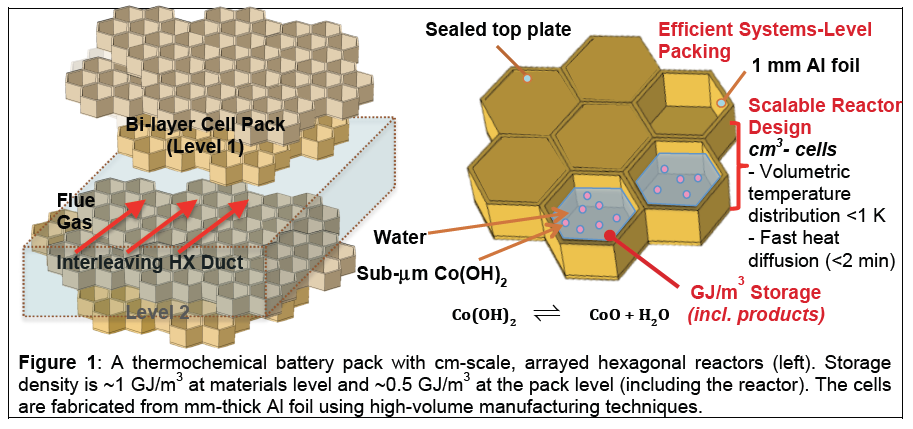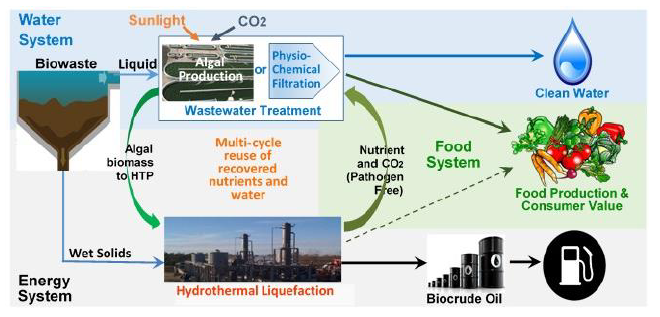MAY 1, 2018 — The Institute for Sustainability, Energy, and Environment (iSEE) is pleased to announce seed funding for the first two sustainability research projects in its Campus as a Living Lab program.
One study will examine possibilities for redirecting waste heat from industrial processes into usable energy through a thermochemical battery, and the other will test a no-waste system for turning food scraps into biofuel while simultaneously treating wastewater and creating natural agricultural fertilizers. Each project will receive $30,000 from iSEE to cover startup costs as the researchers prepare larger proposals through the Institute for substantial external funding of the research.
Launched in February 2018, iSEE’s Living Lab program is designed to link campus sustainability targets to national and global sustainability, energy, and environment challenges — turning campus into a test bed for solutions to real-world problems.
“Transforming university campuses into ‘living laboratories’ is a timely and important campaign,” said Ximing Cai, iSEE’s Associate Director for Campus Sustainability. “Sustainability isn’t just happening ‘out there;’ it’s a consideration every day right here on our campus. By using our own facilities and community as a miniature model of the world at large, we can learn things that will make this campus better, but also make the world better.”
Said iSEE’s Baum Family Director Evan H. DeLucia: “I’m excited to see two of iSEE’s mission areas — research and campus sustainability — furthered, and we are delighted to create new opportunities for faculty and student researchers.”
Read more about the Campus as a Living Lab program >>>
Project Details
Thermochemical Batteries: Turning Waste Heat into an Energy Source
 In everyday life, we think of heat as a measure of temperature. To engineers, however, heat is actually a signal of energy transfer — the “heat” you feel is energy being transferred from a warmer thing to a cooler one.
In everyday life, we think of heat as a measure of temperature. To engineers, however, heat is actually a signal of energy transfer — the “heat” you feel is energy being transferred from a warmer thing to a cooler one.

SINHA
Illinois researchers from the Department of Mechanical Science and Engineering and the Illinois Sustainable Technology Center (ISTC) are planning to harness heat energy currently going to waste (just being exhausted into the air) from industrial sources for other purposes like space heating. The trouble is, the time when energy is needed might not be the same time it is created by waste heat. So the team will create a battery pack capable of storing heat through a series of chemical reactions.
“The key motivation for the concept is to overcome the outstanding issues with thermal (heat) storage: lack of long-term storage, low energy density, expensive systems and inflexibility of upward/downward scalability in designs,” said project leader Sanjiv Sinha, a Professor of Mechanical Science and Engineering.
The initial designs look like stackable honeycombs filled with chemical soup that will soak up and store energy from exhaust heat. In the seed-funded phase of the project, graduate student researchers will study the repeatability of charging and discharging energy in the thermochemical battery, keeping detailed notes on how well the battery holds the power and if and when energy leaks occur. This proof-of-concept will be invaluable for refining the system — and for writing proposals for additional funding.
And the team won’t have to go far to test the prototype battery systems.
“The Abbott Plant on campus has multiple waste heat loss points that could benefit from thermal storage,” the collaborators wrote. “The proposed storage system needs to be designed for multiple scenarios, several of which arise in power plants.
“We plan to acquire and understand the existing waste heat loss data in terms of heat source temperatures, loss quantity, transients, and fluid flow rates associated with the losses. We will use the data to identify the components suited for thermal storage systems and explore designs that match the conditions at Abbott. Broadly, space heating is a large part of the campus’ energy use. In the long term, thermal storage offers the possibility of unique improvements in efficient use and reduced costs for the entire campus.”
The project team includes:
- Sinha, Professor, Mechanical Science and Engineering
- Placid Ferreira, Professor, Mechanical Science and Engineering
- Nenad Miljkovic, Assistant Professor, Mechanical Science and Engineering
- Kishore Rajagopalan, Associate Director for Applied Research, ISTC
Environment-Enhancing Food, Energy, and Water Systems

Process schematic for a novel Environment-Enhancing paradigm for the nexus of food, energy and water systems (EE-FEWS).
The world’s food, energy, and water systems are tightly connected. Sometimes, they work seamlessly together, but often they are competing for the same pool of resources, namely fresh water and clean energy.

ZHANG
In this seed-funded project led by Bioengineering Professor Yuanhui Zhang, researchers from across campus will test a processing system that can deliver not only renewable energy, but also clean water and some bonus organic fertilizers for agriculture. Their design is meant to find synergies between water, food, and energy — where one category’s waste product could be another one’s ingredients.
A process called hydrothermic liquefaction (HTL) sits at the heart of the project.
Biowaste solids like campus food scraps or dried manures are exposed to high heat and pressure, replicating the geological process that created fossil fuels many millennia ago. While the energy-rich molecules of the biowaste become biocrude oil, the other nutrient-rich parts can be used as fertilizers for food production.
Meanwhile, the liquid parts of biowaste can be treated to become clean water. Algae will eat up all the pollutants and leave behind clean water, and they can also be “fed” with the leftover nutrients from the HTL step. At the end of their lifespan, the algae themselves serve as an input for HTL, making sure nothing goes to waste.
Team partners have developed a pilot-sized HTL reactor system that can produce one barrel of biocrude per day, enough to enable additional research on upgrading it to transportation-quality fuel. In fact, the team has already made forays into making bio-sourced forms of diesel, kerosene, and lubricants from the biocrude.
Making campus their living lab, the researchers will rely on the E2-Energy Demonstration Lab at the South Farm Swine Research Center, a Department of Crop Sciences greenhouse, HTL reactors built by the Department of Agricultural and Biological Engineering, and wastewater treatment operations at Urbana-Champaign Sanitary District.
“The U.S. produces an estimated 79 million dry tons of sustainably collectable livestock manure and food processing waste annually,” the researchers wrote. “We will demonstrate that this biowaste stream has the potential to be amplified via multi-cycle nutrient and wastewater reuse to 240-800 million tons of mixed algal-bacteria feedstocks that can be converted (via HTL) into 120-400 million tons of biocrude oil — equivalent to 12-40% of the total petroleum consumed annually in the U.S. — while also cleaning an estimated 7.9 billion tons of wastewater.”
The project team includes:
- Zhang, Professor, Bioengineering
- Paul Davidson, Professor, Bioengineering
- Brenna Ellison, Assistant Professor, Agricultural and Consumer Economics
- Jack Juvik, Professor, Crop Sciences
- Matthew Stasiewicz, Assistant Professor, Food Science and Human Nutrition
- Lance Schideman, Assistant Professor, ISTC
- BK Sharma, Senior Research Scientist, ISTC
- Hong Yang, Chemical and Biomolecular Engineering
More about Campus as a Living Lab
This campaign calls for students, faculty, and staff to work together to use campus and the surrounding community as a testbed to pilot promising new solutions to real-world challenges.
When a specific call for proposals from a national granting agency on research (and extension) projects is posted, quick seed money will be provided for some promising teams who will engage with sustainability issues on campus or in neighborhood communities in their proposal development. Specifically, iSEE wants to leverage this seed money to attract external funds that are relevant to objectives from the Illinois Climate Action Plan (iCAP).
The University of Illinois at Urbana-Champaign (Illinois) has committed to promoting campus sustainability via hundreds of projects on campus under the Illinois Climate Action Plan (iCAP). More than 700 iCAP projects — categorized into energy, water, transportation, building and space, procurement and waste reduction, education, extension, and general research — are online for public assessment. These projects, many based in unique campus facilities or programs, have great potential for developing research and education projects that qualify for outside funding — and on the other hand, the realization of many of campus’ sustainability objectives will need research support.
iSEE has mapped the relevance of iCAP projects to a number of national research programs, which allows campus researchers to identify existing and/or ongoing efforts that can be incorporated into their proposal development for a particular national program.
A report describing the iCAP projects and the links between those projects to major national research programs can be found at the following link: Overviews of Campus Sustainability Projects at Illinois: Opportunities for Education and Research.